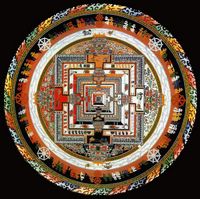NGUỒN GỐC MẠN ĐÀ LA TRONG PHẬT GIÁO MẬT TÔNG ẤN ĐỘ

kalachakra-sand-mandala
Trong khi các từ nguyên theo khoa chú giải văn bản cổ của các thuật ngữ của Phật giáo mật tông thường được nghiên cứu kỹ càng thì những câu kinh có tính mô tả phần lớn lại bị lơ là, đặc biệt là những thuật ngữ tìm thấy trong nền văn hoá Ấn độ nói chung. Từ mạn đà la thường chỉ cho các vật hữu hình, và nghĩa của nó phụ thuộc vào tôn giáo sử dụng, như trong trường hợp của Ấn độ giáo và Phật giáo. Từ này có nguồn gốc từ Ấn Độ giáo, nhưng cũng được sử dụng trong kinh điển Phật giáo. Trong tiếng Sanskrit, từ mạn đà la chỉ cho các đồ hoa., biểu đồ hay hình hình học biểu thị cho vũ trụ một cách siêu hình hay biểu tượng, một hình ảnh thu nhỏ của vũ trụ tu8` quan điểm của con người.
Mạn đà la có thể mô tả bằng hình ảnh một quang cảnh của xứ Phật, hay trí tuệ giác ngộ của Ịức Phật. Mạn đà la thường được dùng như một phương tiện giúp cho việc hành thiền của các tu sĩ Ấn Ịô. giáo cũng như Phật giáo. Trong phái Nhật Liên Tông của Nhật, Mạn đà la là một cuộn giấy ghi thư pháp chữ Hán, thể hiện đời sống giác ngộ của Ịa.i Sư Nhật Liên, người sáng lập nên tông phái này, và là vật được các đệ tử của phái này thờ kính.
Mạn đà la bằng cát của Tây Tạng được làm một cách rất công phu bởi các vị sư Tây Tạng trên nền chùa. Các hình ảnh khác nhau trên đồ hình biểu tượng cho các đối tượng cần được tôn thờ và quán tưởng theo vũ trụ quan của Phật giáo Tây Tạng. Để biểu tượng cho định luật vô thường, những mô hình phức tạp vốn là một công trình làm rất là tỉ mĩ . Các vị sư Tây Tạng đã kết hợp rất công phu mỗi lần chỉ một vài hạt cát để tạo hình Mạn Đà Lạ
Vài tuần lễ sau khi hoàn tất, toàn bộ công trình vất vã tạo thành Mạn Đà La được rãi xuống dòng sông như một lời cầu nguyện bình an, nhiều phước lành. Đây cũng là nói lên sự vô thường luôn biến đổi, một trọng tâm của giáo pháp nhà Phật.
Do Sư Cô Liễu Pháp dịch
Arcane Cosmopolis: Mandala Origins in the Indian Buddhist Tantras
Center for Buddhist Studies Colloquium with Ron Davidson, Fairfield University
While hermeneutical etymologies of Buddhist tantric terms have sometimes been considered in the case of Indian esoteric Buddhism, other descriptive statements have been largely ignored, especially in the case of those terms shared with Indian culture in general. The term mandala may be applied to various tangible objects, depending upon the particular religious practice that uses the term, especially as seen in Hinduism and Buddhism. The term has Hindu origins but is also used in the Buddhist context. At its root it is the generic Sanskrit term for any plan, chart, or geometric pattern which represents the cosmos metaphysically or symbolically, a microcosm of the universe from the standpoint of man. A mandala may also graphically depict a landscape of the Buddha land or the enlightened vision of a Buddha. Mandalas are commonly used by Hindu and Buddhist monks as an aid to meditation. In Nichiren Shoshu Buddhism, the mandala is a scroll of Chinese calligraphy that embodies the enlightened life condition of Nichiren Daishonin, the founder of that Buddhist practice, and is the highest object of worship to which his followers chant the words "Nam Myoho Renge Kyo." The photograph above is a good example of a Tibetan sand mandala. This pattern is painstakingly created on the temple floor by several monks a few grains of sand at a time. The various aspects of the design represent symbolically the objects of worship and contemplation of the Tibetan Buddhist cosmology. To symbolize impermanence (a central teaching of Buddhism), after many weeks or months of creating the intricate pattern, the entire work is usually placed in a body of running water to spread the blessings of the Mandala. A mandala can be used during meditation as an object for focusing the eyes on, especially the center of the mandala. This accounts for the symmetrical geometric shapes which mandalas tend to have, tending to draw the attention of the eyes towards their center. This paper will discuss the origins of Buddhist tantric mandalas in the real politik of early medieval India, when feudal states emerged from rural and tribal areas. The mandalas' founding mythologies and the ideology of their pronouncements will be related topics, especially as they pertain to questions of secrecy and revelation.
0 Comments:
Đăng nhận xét
<< Home